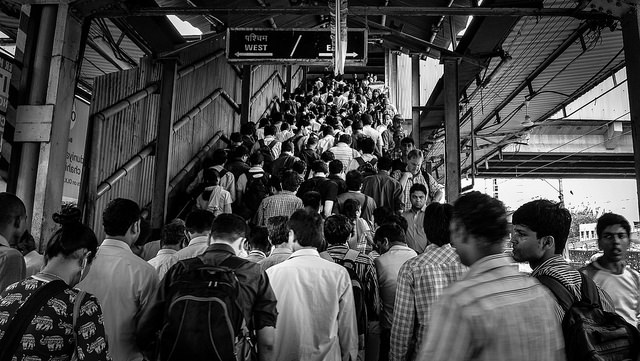
Asit K Biswas and Kris Hartley
POLICY FORUM | November 18, 2015
China and India’s rapid urbanisation could be a recipe for employment-related social instability, write Asit K Biswas and Kris Hartley.
China and India are experiencing rapid urbanisation, with rural-to-urban migration occurring at historically unprecedented rates. City planning and economic policy have struggled to keep pace with this demographic shift, and global economic competition may force both countries to eventually confront employment-related social instability. Are they prepared for this crisis?
Urban growth in China is strikingly prolific. In 1978, China’s cities accounted for only 18 per cent of the total population. By 2012, urban residents outnumbered rural, and in 2014 54 per cent of nearly 1.3 billion citizens lived in cities. The government plans for 60 per cent by 2020, and 70 per cent by 2025. Further, China’s 274 million migrant workers would alone be the world’s fourth largest country.
Although India now has the world’s largest rural population (857 million), it has likewise seen a steady rise in urban population share. According to World Bank data, from 1960 to 2014 India’s urban population percentage nearly doubled, from 17 per cent to 32 per cent. The UN predicts an increase of 404 million urban residents in India over the next 40 years; this is nearly equal to the current urban population of 410 million. As such, India will add as many urban residents in 40 years as it has already done in its entire history. Together with Nigeria, India and China will account for more than a third of the world’s urban population growth by 2050.
These statistics should elicit more concern than pride, especially for policymakers. The heady days of double-digit economic growth are waning. China’s once-hot economy appears to be cooling, although some analysists argue that warnings of a full-blown downturn are overstated. India’s outlook is not much better; the country’s economic recovery is behind schedule, and the IMF is pessimistic about continued growth prospects.
Amidst these structural challenges, the employment outlook is dim. Unskilled and semi-skilled factory jobs are quickly disappearing in both China and India, as rapid automation and mechanisation (deemed by some a “robot revolution”) gain popularity among ever-cost-conscious producers. Further, wages continue to rise in China (by 70 per cent since 2009) and India, compromising competitiveness relative to regional peers. Countries such as Vietnam, Cambodia, and Thailand are already poaching investors and developing industrial infrastructure.
Exacerbating these challenges is the growing thirst for a higher standard of living, particularly as Chinese and Indian workers become more educated and seek jobs matching their rising skill sets. These expectations are further stoked by the ICT revolution, which democratises information and connects like-minded people (even as China’s Great Firewall grows higher). The confluence of urban overcrowding, an anaemic domestic job market, and technology-enabled networking could be a recipe for social instability. For example, the China Labour Bulletin of Hong Kong found that there have been more than 1,600 labour protests and strikes in China since January, compared to 1,379 in all of 2014 and only 185 in 2011.
India likewise faces the dire prospect of social unrest due to a rapidly expanding labour pool (i.e. a demographic dividend). It is doubtful that employment opportunities will satisfy the surge of 136 million additional workers expected in the next decade. India must create 12 million new jobs per year for this rising demographic, while balancing existing unemployment and under-employment (the country now accounts for one fifth of the world’s working age population).
The spectre of under-employment also plagues the Chinese job market, as a glut of university graduates floods the country’s otherwise tepid economy; in 2014 unemployment among new graduates was 16 per cent compared to 3 per cent for graduates overall.
The emerging labour force is arguably mismatched with the current and future needs of employers, particularly as technology redefines jobs not only on factory floors but also in back offices. Conditions are likely to worsen because the ability of universities to revise curricula lags the near-instantaneous shifts in skill demand resulting from global economic shifts. As such, both countries are failing to devote enough attention to the urgent issue of tertiary education and vocational training.
Restructuring and reforming the world’s two largest economies (China at US$11 trillion and India US$2 trillion) is a daunting task that must be approached with pragmatism and consistency on all policy fronts.
In early October, China made a bold commitment to lift the country’s 70 million poor out of poverty in the next six years. Urban congestion, social restlessness, environmental degradation, and geo-political instability also plead for attention from both governments. The rest of the world is understandably interested in the success of its two largest economies, and neither can rest on labour cost advantages anymore; they must compete on quality. However, their workforce development efforts lack the flexibility (and in India, the political resolve) to manage rapid shifts in skill demand, let alone the flood of under-employed and disaffected workers.
Asit K. Biswas is the Distinguished Visiting Professor, Lee Kuan Yew School of Public Policy. National University of Singapore, Singapore. Kris Hartley is a Visiting Lecturer at Vietnam National University (HCMC), and a PhD Candidate at the Lee Kuan Yew School of Public Policy (NUS).
Source: http://bit.ly/1lxiGGm